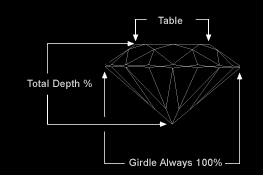
Color Detail
Whether you are looking at Canadian diamonds or diamonds from anywhere else in the world, the best color is no color. Diamonds allow light to be reflected and dispersed as a rainbow of color. This light dispersion, or color flash, has no effect on the technical grading of color. The absolute finest colorless stone carries a D rating, descending through each letter of the alphabet to Z, designating a diamond of light yellow, brown, or gray. This body color may be caused by the presence of trace elements, such as nitrogen, within the atomic framework of the carbon crystal. These trace elements are so minute that they are scientifically measured in parts per million (ppm). As the body color becomes more intense, the grade for color descends the scale. These gradations are so minute and precise that discerning a single grade (even by an expert) under less than ideal laboratory conditions is extremely difficult. It is always best to compare diamonds graded by either the Gemological Institute of America (GIA) or the American Gem Society (AGS) for accurate color grading. When directly comparing diamonds for color, most consumers are unable to detect a difference unless they are at least two or three color grades apart. We recommend selecting a diamond with a color grade of J or better. Diamonds graded D, E, and F are more expensive because they are more rare. However, well cut diamonds with good clarity of all color grades can be equally dazzling, as it is the interplay of the 4C’s that determines each diamond’s unique beauty.
Fancy Color
It is often surprising to learn that diamonds also occur by rare accidents of nature in shades of pink, blue, green, amber, or even red. These rarely occurring colors are referred to as fancies and are evaluated by a different set of color standards. These standards take into consideration various factors such as hue and saturation. Fancy colored diamonds are the most expensive because of their extreme rarity. Some fancy colors can cost hundreds of thousands of dollars for diamonds of one carat or less!
Fluorescence
Fluorescence is not directly related to a diamond’s color. This separate characteristic refers to the diamond’s ability to fluoresce under ultraviolet (UV) light. Our sun emits some UV light, but it is usually not great enough to detect fluorescence. The most common source of UV is a black light. When exposed to UV light, many diamonds will give off a distinctive glowing blue coloration. Although fluorescence may be displayed in various colors, blue is the most common in diamonds. The fluorescence of a diamond is defined by its intensity as either None, Faint, Medium, Strong, or Very Strong. Although fluorescence is a characteristic that can be measured, it is seldom an issue when selecting a diamond.



